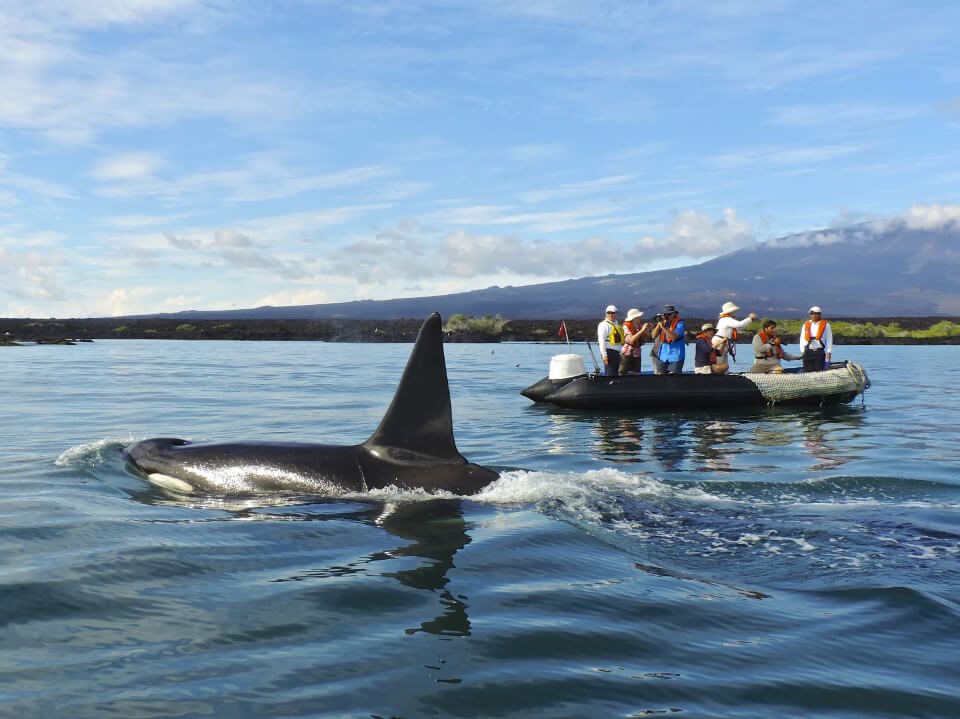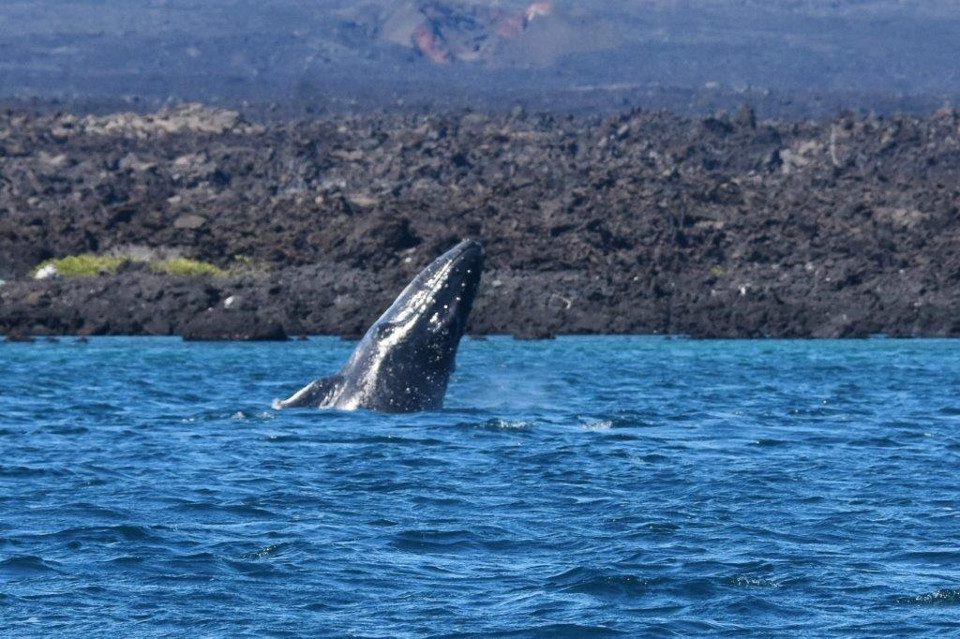The Galapagos Islands are home to over 24 different species of dolphins and whales. Some of these species are year-round residents while others pass through during their migrations. The best time and place to see them is between June and October, and the best location is in the channel between the islands of Isabela and Fernandina. Whale and dolphin watching in the Galapagos are one of the most incredible and unforgettable experiences of life.
How Whale and Dolphin Watching Works
Whale and dolphin watching can be done by land on occasion, but it is typically done by boat. This can be on your cruise, or you can take a separate charter boat specifically to see whales. Whale and dolphin watching will often include the guidance of a naturalist who can teach you about the species you are seeing. Proper whale watching techniques require that you keep a safe distance from whales while underway. However, captains may turn off the boat and allow curious whales to approach you for a closer look. All vessels operating in Galapagos have clear guidelines for “whale and dolphin watching vessel etiquette”.
Get a close look at whales and dolphins in the Galapagos Islands! Experience this unbelievable moment aboard Santa Cruz II Cruise!
Types of Whales

Whales and dolphins come in two distinct types: the toothed whales and the baleen whales. Dolphins, porpoises, and orcas are all a part of the toothed whale family, as are sperm whales. They are typically, but not always, fish eaters. Blue, humpback, and other baleen whales comprise the second main family. Baleen whales do not have teeth but do have a fine comb in their mouth, which they use to filter plankton and small fish from the water. They feed by allowing swallowing large gulps of water into their mouths and then filtering the food while pushing with their massive tongues the water out through their “teeth” or baleen, which acts as a colander and keeps the food in their mouth.
When to See Whales and Dolphins
The most viable time for whale and dolphin watching is between June and October, though there are some resident species that can be seen at any time. One thing to understand about a whale and dolphin watching trip is that it can be particularly tough to gauge exactly when they will show up. Whales cover a lot of water ocean in their home range, and although experienced guides can visit their most common grounds, they cannot predict with certainty when a whale will be there. Some species are very likely to emerge, such as dolphins, who often love riding bow wakes, but there is never a guarantee when it comes to seeing these majestic marine creatures.
TALK TO A DESTINATION EXPERT

Diego Zapata

Rosa Mena

Sandy Lara

Diego Zapata

Rosa Mena

Sandy Lara
Common and Popular Galapagos Whale and Dolphin Species
Though there are a large number of species that have been occasional visitors to the Galapagos islands, other species are seen with regularity each year, either as residents or regular migrants.
Orcas
Orcas, or killer whales, are found commonly in most of the world’s waters. They are broken into three population types: residents, transients, and offshore orcas. Residents are populations that stay in an area year-round and congregate in large, friendly groups. They are the most popular type of orcas to see while whale watching because they are playful and curious and have been known to interact with boats. Transient whales are the mammal-eaters. They travel in smaller hunting packs and spend less time interacting with people. Offshore whale groups are typically seen in the open ocean and travel in very large packs that roam worldwide. Very little is known about this whale group.
Blue Whales
The largest whale species in the world, as well as the largest animals, blue whales are an incredible sight to see. These baleen whales stretch the length of three football fields and typically live a solitary life in large, open-ocean settings. The Galapagos Islands are one of the few places near land where they are seen with some regularity.
Humpback Whales

These baleen whales are known for their playfulness, and they are one of the largest whale species that breach (leap from the water) regularly. They break the mold when it comes to baleen whales because they not only eat plankton but also small feeder fish. They feed by creating a bubble net that walls fish into a tight circle. Once they have been contained, the whale will swim beneath the column of fish and rise toward the surface with its mouth open wide. In Galapagos, Humpbacks are limited to the cooler months between June and October. Mostly cows with their calves are visible. These females generally do not forage while in Galapagos but rely on their fatty reserves while nursing their calves.
Bottlenose Dolphins
These dolphins are some of the most common marine mammals in the Galapagos Islands. They are frequently seen riding the wake of cruise ships, yachts, and other boats. Bottlenose dolphins travel in large groups, making them especially fun to spot while you’re whale and dolphin watching.
Sperm Whale
The classic whale from Moby Dick, sperm whales are the largest toothed whale and are part of a small family with only three existing species. They are solitary whales and fish eaters. In Galapagos occasionally pods come together of several individuals.
Minke Whale
This is one of the smaller species of baleen whale and also the world’s most populous baleen whale. It exists worldwide and feeds on plankton. These whales are typically 8-10 tons with pointed noses and white patches under the pectoral fins.
Bryde Whale
This may as well be the most common large whale seen in Galapagos. Also known as Tropical Whale, these large mammals are restricted to warmer seas.
Common Dolphin
Contrary to the name, common dolphins are less common in the Galapagos than bottlenose dolphins, though they are still regular visitors. They can be differentiated from bottlenose dolphins by the fact that they are a single color along their sides (bottlenose dolphins are two-toned, with a lighter belly than back) and have a dark stripe running from flipper to chin.
Learn more about Galapagos tips before your trip here

Javier Garcia

Eduardo Silva

Carolina Escobar
START PLANNING YOUR TRIP

Javier Garcia

Eduardo Silva

Carolina Escobar
Get in touch for more
CONTACT US


